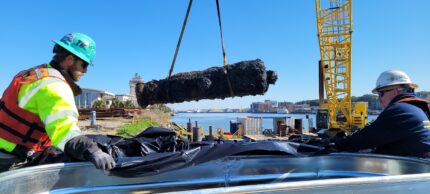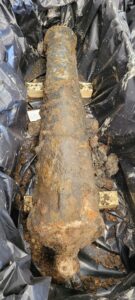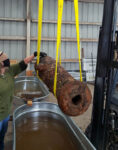In a complex salvage operation, archaeologists have recovered 15 rare Revolutionary War-era cannon from the Savannah River in Savannah, Georgia.
The first cannon were discovered by the US Army Corps of Engineers in February 2021 during dredging operations at a spot near the former Fort Jackson known as Five Fathom Hole for its unusual depth. The area had already been dredged several times in the past, so the discovery of three iron cannons, an anchor and large fragments of ship timbers came as a surprise.
 Pieces of the Confederate warship CSS Georgia had been found before in the Savannah River, but these cannons were five feet long, which indicated a far earlier date in the mid-1700s. While it’s possible the George had repurposed cannon made a century before the Civil War, archaeologists and naval historians believed they likely came from a Revolutionary War vessel.
Pieces of the Confederate warship CSS Georgia had been found before in the Savannah River, but these cannons were five feet long, which indicated a far earlier date in the mid-1700s. While it’s possible the George had repurposed cannon made a century before the Civil War, archaeologists and naval historians believed they likely came from a Revolutionary War vessel.
At the time of the initial finds, there was speculation they could have come from the HMS Rose, a Royal Navy warship that was deliberately scuttled on the sandbar at the mouth of the Savannah River in September of 1779 to close off access to the French fleet. Savannah had been captured by the British in 1778, and between September and October of 1779, combined French and American forces besieged the city in an attempt to wrest it from British hands. However, additional research into the HMS Rose found records that it was sunk further upriver and that its 20 cannon were recovered from the ship before it was scuttled.
 Dredging operations were halted after the first finds were made to give archaeologists the opportunity to scan the area with sonar. The sonar surveys revealed another dozen cannon on the riverbed at Five Fathom Hole. The thick mud of the bed made recovery challenging, but a team of divers painstaking strapped slings underneath one cannon at a time and then used inflatable lift bags to pull the heavy iron cannon out of the muck. They were moved to shallower, most stable bed area and finally hoisted out by crane.
Dredging operations were halted after the first finds were made to give archaeologists the opportunity to scan the area with sonar. The sonar surveys revealed another dozen cannon on the riverbed at Five Fathom Hole. The thick mud of the bed made recovery challenging, but a team of divers painstaking strapped slings underneath one cannon at a time and then used inflatable lift bags to pull the heavy iron cannon out of the muck. They were moved to shallower, most stable bed area and finally hoisted out by crane.
The cannon were then transported to a conservation laboratory where they were measured, cleaned and documented before being submerged in conservation tanks. Even though the cannons were thickly coated with concretions, it was clearly from the initial examination that they were all different types. The anchor fragments recovered from the site are also  diverse. This suggests the objects came from several ships, not just one. British archives indicate some of the cannon may have came from two or more commercial ships engaged by the British as troop transports and then hastily sunk as blockships when a large French fleet suddenly materialized off Tybee Island.
diverse. This suggests the objects came from several ships, not just one. British archives indicate some of the cannon may have came from two or more commercial ships engaged by the British as troop transports and then hastily sunk as blockships when a large French fleet suddenly materialized off Tybee Island.
Study and conservation of the cannon is predicted to take years, but the ultimate goal is to select the best representatives to go on permanent display in a local museum to illuminate Savannah’s pivotal role in the Revolutionary War.